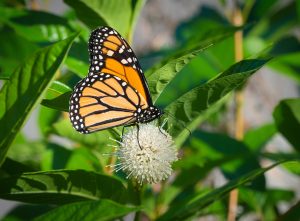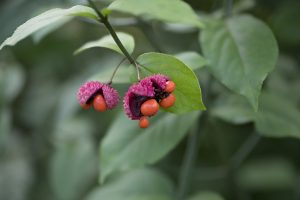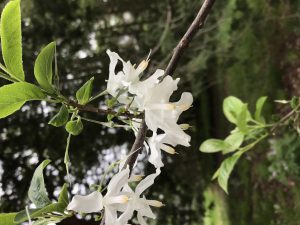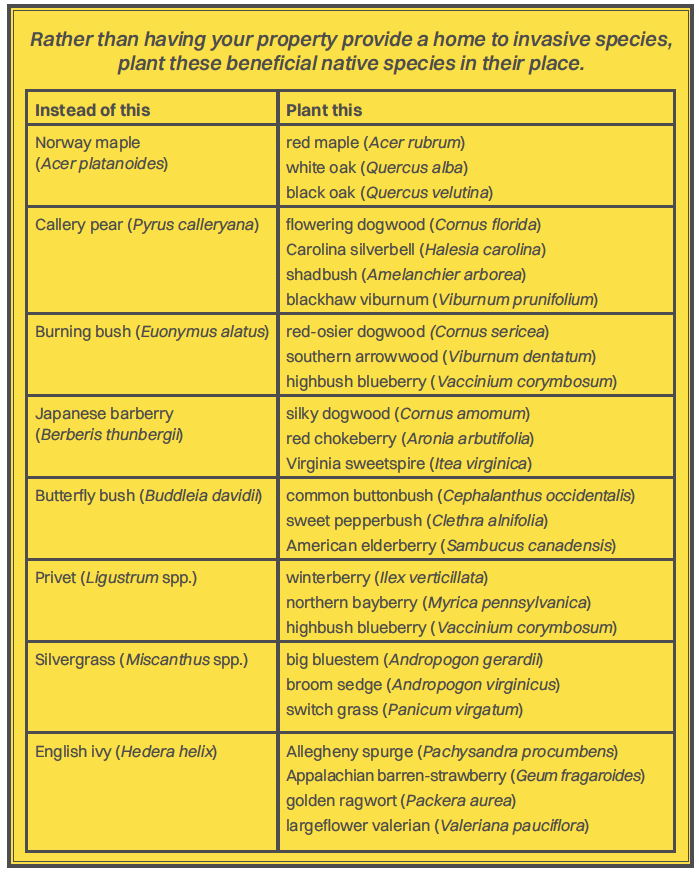Plant This, Not That
Photos by Laura Cruz, David Korbontis and Samantha NestoryBurning bush is just one of the invasive species to remove and replace on your property.

Late last year, the Pennsylvania Department of Agriculture announced plans to ban the sale of burning bush, Euonymus alatus. Burning bush is an invasive species, meaning it’s not native to our region and spreads without any natural checks.
The plant originates from northeastern Asia and was brought to North America around 1860 as an ornamental shrub. Popular for its bright red fall foliage, the plant is spread by birds that carry berries into the woodlands where it crowds out native species, upsetting the forest ecosystem.

While burning bush will enjoy a grace period until January 2025, when the ban takes effect, landowners can act now to remove and replace these shrubs on their property with native species. Not only will making the swap prevent invasive spread, the alternatives suggested in this article will improve the biodiversity in your landscape. They’ll attract beneficial insects that in turn feed birds and small mammals.
Consider replacing any burning bush on your property with —
-

Hearts-a-bustin (Euonymus americanus) Red twig dogwood (Cornus sericea), which offers striking scarlet stems, as its name implies.
- Winterberry holly (Ilex verticillata), which has green leaves that drop away in winter, leaving a display of bright red berries that persist until songbirds gobble them up.
- Southern arrowwood (Viburnum dentatum), which sports clusters of white flowers in spring and fall color ranging from yellow to red. It’s the host plant of the blue azure butterfly.
- Wahoo (Euonymus atropurpureus) or hearts-a-bustin (Euonymus americanus), which both have red berries (note: berries are edible by birds, but poisonous to humans).

Other recently banned plants in Pennsylvania include Callery pear (Pyrus calleryana), Asian and European privet species (Ligustrum sinense, Ligustrum japonicum and Ligustrum vulgare) and Japanese barberry (Berberis thunbergia).
“To see how easily these invasive plants spread into natural areas, just hike into the woods anywhere around here. Our land stewardship staff and volunteers spend thousands of hours every year trying to control invasive species on our preserves,” said Gary Gimbert, Natural Lands’ vice president of stewardship. “When they take hold, they create a monoculture. Native species can’t compete, which means the animals and insects that depend on the natives struggle for food and shelter.”
Gimbert added, “Hopefully people will begin to realize that plants don’t care about property boundaries. So, if it’s in your yard, it’s also going to end up in forests and fields.”
Do the right thing, and plant native species on your property.

Natural Lands is dedicated to preserving and nurturing nature’s wonders while creating opportunities for joy and discovery in the outdoors for everyone. As the region’s oldest and largest land conservation organization, it has preserved more than 125,000 acres, including 42 nature preserves and one public garden totaling more than 23,000 acres. Nearly five million people live within five miles of land under the organization’s protection. Land for life, nature for all. NatLands.org.
Our Favorite Resources
- B&D Builders
- Ball & Ball
- Berk Hathaway Holly Gross
- Berk Hathaway Kit Anstey
- Berk Hathaway M. Schwartz
- Canvas Valley Forge
- Dewson Construction
- DiSabatino Landscaping
- King Construction
- McComsey Builders
- Monument/Sotheby’s Int’l
- Mostardi Nursery
- Mountaintop Construction
- Renewal Dynamics
- Sheller Energy
- White Horse Construction
